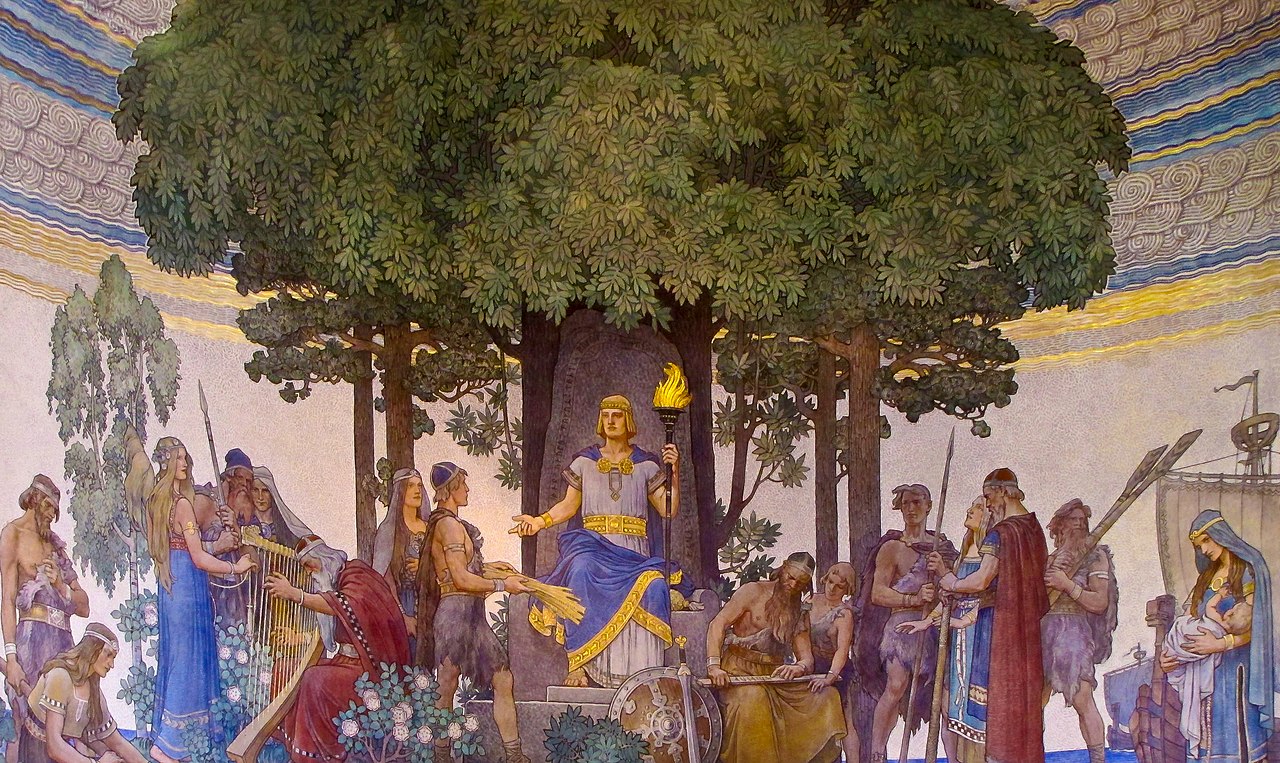In Old Norse texts, such as Snorri Sturluson's Prose Edda, Jarnsaxa is described as a goddess of the sea, Thor's lover, and the mother of Magni and Modi. She is also listed as one of the nine mothers of Heimdall.
Despite being the mother of Heimdall and one of Thor’s lovers, her relationship with the Æsir gods (Odin, in particular) is somewhat contentious.
What is Jarnsaxa the Goddess of?
Jarnsaxa was one of the nine goddesses of the sea, who also gave birth to the white god, Heimdall.
The nine goddesses of the sea include:
- Angeyja
- Atla
- Eistia
- Eyrgiafa
- Gialp
- Greip
- Imb
- Jarnsaxa
- Ulfrun
The nine mothers of Heimdall are also referenced as the Nine Daughters of Ægir and Rán. Rán, in Old Norse texts, is the goddess of the sea.
As listed above, each of her nine daughters are jötunn representing the waves on the ocean.
What Does the Name “Jarnsaxa” Mean?
Her name means iron dagger in Swedish, which combines the words jarn (iron), yxa (axe), and scissors (saxa).
Some other translations of her name mean “iron dagger” or “armed with an iron sword.”
Is Jarnsaxa A Giant?
Yes, Jarnsaxa was considered one of the jötunn ice giants.
Her parents were ice giants named Rán and Ægir, and they gave birth to the nine mothers of Heimdall. Jarnsaxa’s roots as an ice giant (a notable adversary to the Æsir gods) and her relationship with Thor and Loki cause a bit of a stir in the old Norse sagas.
What are some of the things that Jarnsaxa is associated with?
What we know about this ice giant lies in her relationships with notable Æsir gods.
Thor and Jarnsaxa
In all of the surviving Norse sagas, Jarnsaxa takes on only one partner: Thor. The two give birth to two sons, Magni and Modi, who are destined to survive the destruction at Ragnarök and go on to forge the new world. In the Skáldskaparmál (Prose Edda), Odin hints that he isn’t a big fan of the jötunn goddess or her children.
When Thor becomes trapped under the leg of the ice giant Hrungnir, no Æsir gods have the strength to lift the leg off of the Thunder god. When his son, Magni, arrives and frees his father, Thor is so thankful to his son that he offers Magni Hrungnir’s horse, Gullfaxi.
However, Odin becomes angered by Thor’s gesture. He states that Magni is half jötunn (since his mother is Jarnsaxa), an enemy of the Æsir gods, and doesn’t deserve such a magnificent horse. And Odin takes the horse for himself.
Jarnsaxa’s Children
Jarnsaxa is the mother of three children, Magni, Modi, and Heimdall.
- Magni: Magni is the oldest of Thor’s sons and is the god of strength. He’s so powerful that he is the only Æsir god able to lift the leg of Hrungnir off Thor’s neck.
- Modi: Modi is the god of courage and the younger son of Thor and Jarnsaxa.
- Heimdall: Jarnsaxa is one of Heimdall’s nine mothers. While his father isn’t exactly clear, some scholars believe it’s Odin.
Jarnsaxa’s Attestations
Poetic Edda
In the poem Hyndluljóð, we learn that Jarnsaxa is one of the nine mothers of Heimdall. It is one of the only references to Jarnsaxa in the original Nordic texts.
Prose Edda
In Snorri Sturluson’s Prose Edda, we learn a little more about Jarnsaxa. For instance, in the Skáldskaparmál, we discover that she is the mother of Magni and Modi and that Odin isn’t much of a fan of the relationship between Thor and Jarnsaxa.
It’s also important to note that within that same poem (the Skáldskaparmál), Sif refers to herself as Jarnsaxa, which makes things confusing. Some scholars see this passage as an indication that Jarnsaxa was just another name for Sif.
It’s not uncommon for Norse gods to go by many names (looking at you, Freyja). However, some also believe this passage can be translated as the “rival of Jarnsaxa,” which makes sense since Jarnsaxa is referenced as Thor’s first wife.
Jarnsaxa in Modern Culture
While there isn’t much known about the sea goddess Jarnsaxa, her legacy lives on in space! In 2006, a group of NASA scientists named Scott S. Sheppard, Jan Kleyna, and David C. Jewitt discovered a moon of Saturn and named it after the Norse goddess Jarnsaxa.
Saturn has a Norse group of moons that all travel in opposite orbits around the sun. Other Norse moons of Saturn include Gerd, Fenrir, Phoebe, Mundilfari, Aegir (Jarnsaxa’s father), and Ymir.

